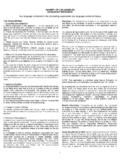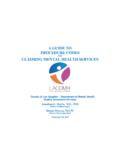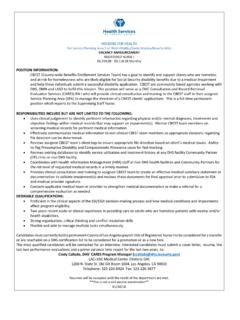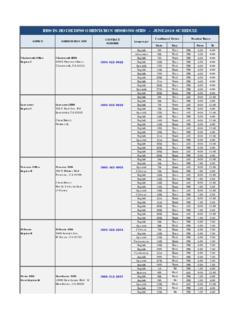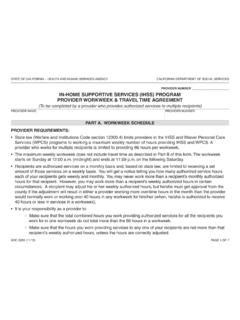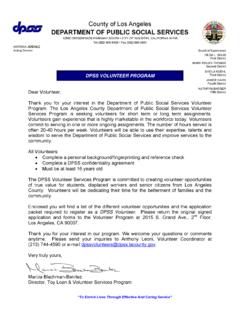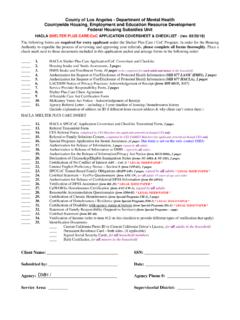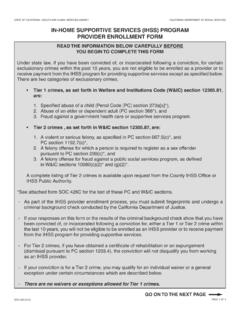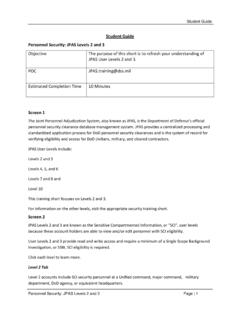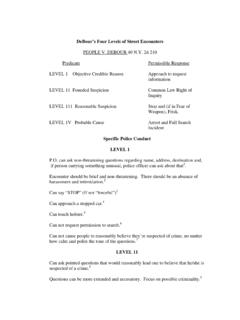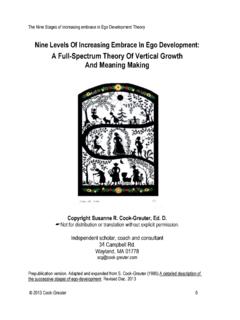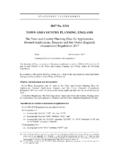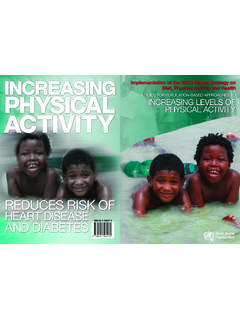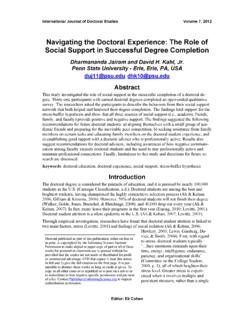Transcription of Family Guide to The Rancho Levels of Cognitive …
1 _____provided as a courtesy by Rancho Los Amigos National Rehabilitation CenterCommunication Disorders Department 7601 E. Imperial Highway Downey, CA 90242(562) 401-7682 FAX: (562) 401-6690 please visit us at INFORMATIONF amily Guide to The Rancho Levels of Cognitive FunctioningCognition refers to a person's thinking andmemory skills. Cognitive skills include payingattention, being aware of one's surroundings,organizing, planning, following through ondecisions, solving problems, judgement,reasoning, and awareness of problems. Memoryskills include the ability to remember thingsbefore and after the brain injury.
2 Because of thedamage caused by a brain injury, some or all ofthese skills will be Rancho Levels of Cognitive Functioning isan evaluation tool used by the rehabilitation eight Levels describe the patterns or stages ofrecovery typically seen after a brain injury. Thishelps the team understand and focus on theperson's abilities and design an appropriatetreatment program. Each person will progress attheir own rate, depending on the severity of thebrain damage, the location of the injury in thebrain and length of time since the brain individuals will pass through each of theeight Levels , while others may progress to a certainlevel and fail to change to the next higher is important to remember that each person is anindividual and there are many factors that need tobe considered when assigning a level of are a range of abilities within each of thelevels and your Family member may exhibit someor all of the behaviors listed LEVEL I NO RESPONSEA person at this level will: not respond to sounds, sights, touch LEVEL IIGENERALIZED RESPONSEA person at this level will: begin to respond to sounds, sights, touch ormovement; respond slowly, inconsistently, or after a delay.
3 Responds in the same way to what he hears, seesor feels. Responses may include chewing,sweating, breathing faster, moaning, moving,and/or increasing blood LEVEL IIILOCALIZED RESPONSEA person at this level will: be awake on and off during the day; make more movements than before; react more specifically to what he sees, hears, orfeels. For example, he may turn towards a sound,withdraw from pain, and attempt to watch aperson move around the room; react slowly and inconsistently; begin to recognize Family and friends; follow some simple directions such as "Look atme" or "squeeze my hand"; begin to respond inconsistently to simplequestions with "yes" and "no" head Family /friends can do at Cognitive Levels I, II, and III Explain to the individual what you are about todo.
4 For example, "I'm going to move your leg." Talk in a normal tone of voice. Keep comments and questions short and example, instead of "Can you turn your head_____provided as a courtesy by Rancho Los Amigos National Rehabilitation CenterCommunication Disorders Department 7601 E. Imperial Highway Downey, CA 90242(562) 401-7682 FAX: (562) 401-6690 please visit us at me?", say, "Look at me". Tell the person who you are, where he is, whyhe is in the hospital, and what day it is. Limit the number of visitors to 2-3 people at atime. Keep the room calm and quiet. Bring in favorite belongings and pictures offamily members and close friends.
5 Allow the person extra time to respond, butdon't expect responses to be the person may not respond at all. Give him rest periods. He will tire easily. Engage him in familiar activities, such aslistening to his favorite music, talking aboutthe Family and friends, reading out loud tohim, watching TV, combing his hair, puttingon lotion, etc. He may understand parts of what you aresaying. Therefore, be careful what you say infront of the LEVEL IVCONFUSED AND AGITATEDA person at this level may: be very confused and frightened; not understand what he feels or what ishappening around him; overreact to what he sees, hears, or feels byhitting, screaming, using abusive language, orthrashing about.
6 This is because of theconfusion; be restrained so he doesn't hurt himself; be highly focused on his basic needs; ie.,eating, relieving pain, going back to bed, goingto the bathroom, or going home; may not understand that people are trying tohelp him; not pay attention or be able to concentrate fora few seconds; have difficulty following directions; recognize Family /friends some of the time; with help, be able to do simple routineactivities such as feeding himself, dressing Family /friends can do at CognitiveLevel IV: Tell the person where he is and reassure him thathe is safe. Bring in Family pictures and personal items fromhome, to make him feel more comfortable.
7 Allow him as much movement as is safe. Take him for rides in his wheelchair, withpermission from nursing. Experiment to find familiar activities that arecalming to him such as listening to music, eating,etc. Do not force him to do things. Instead, listen towhat he wants to do and follow his lead, withinsafety limits. Since he often becomes distracted, restless, oragitated, you may need to give him breaks andchange activities frequently. Keep the room quiet and calm. For example,turn off the TV and radio, don't talk too muchand use a calm voice. Limit the number of visitors to 2-3 people at LEVEL VCONFUSED AND INAPPROPRIATEA person at this level may: be able to pay attention for only a few minutes; be confused and have difficulty making sense ofthings outside himself; not know the date, where he is or why he is inthe hospital; not be able to start or complete everydayactivities, such as brushing his teeth, even whenphysically able.
8 He may need step-by-stepinstructions; become overloaded and restless when tired orwhen there are too many people around; have avery poor memory, he will remember past eventsfrom before the accident better than his dailyroutine or information he has been told since theinjury; try to fill in gaps in memory by making things up;(confabulation)_____provided as a courtesy by Rancho Los Amigos National Rehabilitation CenterCommunication Disorders Department 7601 E. Imperial Highway Downey, CA 90242(562) 401-7682 FAX: (562) 401-6690 please visit us at may get stuck on an idea or activity(perseveration) and need help switching to thenext part of the activity; focus on basic needs such as eating, relievingpain, going back to bed, going to thebathroom, or going Family /friends can do at CognitiveLevel V.
9 Repeat things as needed. Don't assume that hewill remember what you tell him. Tell him the day, date, name and location ofthe hospital, and why he is in the hospitalwhen you first arrive and before you leave. Keep comments and questions short andsimple. Help him organize and get started on anactivity. Bring in Family pictures and personal itemsfrom home. Limit the number of visitors to 2-3 at a time. Give him frequent rest periods when he hasproblems paying LEVEL VICONFUSED AND APPROPRIATE A person at this level may: be somewhat confused because of memoryand thinking problems, he will remember themain points from a conversation, but forgetand confuse the details.
10 For example, he mayremember he had visitors in the morning, butforget what they talked about; follow a schedule with some assistance, butbecomes confused by changes in the routine; know the month and year, unless there is asevere memory problem; pay attention for about 30 minutes, but hastrouble concentrating when it is noisy orwhen the activity involves many steps. Forexample, at an intersection, he may be unableto step off the curb, watch for cars, watch thetraffic light, walk, and talk at the same time; brush his teeth, get dressed, feed himself etc.,with help; know when he needs to use the bathroom; do or say things too fast, without thinking first; know that he is hospitalized because of an injury,but will not understand all of the problems he ishaving; be more aware of physical problems thanthinking problems; associate his problems with being in the hospitaland think that he will be fine as soon as he Family /friends can do at Cognitive Level VI: You will need to repeat things.
